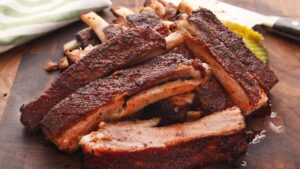Is there a recommended amount of meat to serve each person?
For any meal, barbecue party, or full-blown feast that will include meat in some form or another, it is critical to know how much of it you will need to prepare ahead of time and fill your pantry with enough supplies. In such case, how much meat should be served each person?
As a general rule, the quantity of meat that fits comfortably in the palm of your hand is a decent measure of how much meat is healthy for you in each meal. On average, 8 ounces of meat is consumed by an adult individual every day.
There is nothing more frustrating than running out of food before your guests (and yourself) have had enough to eat.
While it is possible to dash out to the local store and pick up a few snacks, this will not suffice in this situation. This is especially true if your meal included a superbly cooked meat dish of some kind.
You may, of course, go overboard and purchase a significant quantity of meat in advance, but unless you have a lot of money to spare, this isn’t always an option. And, as the vast majority of us do not, let’s talk about the number of meat servings per person that should be deemed ideal for your budget, health, and hunger.
That are the people who will be attending your event?
It is essential to consider who you will be feeding as the initial step in your planning process. Although the amount of the meal varies from person to person, you may draw numerous generalizations if you split your guests into age groups: children, teens, adults, and those in their golden years.
One or more of them may have an extraordinary taste for the person who represents that group in this situation. To be safe, unless you want to indulge them and are aware of their tastes, following healthy recommendations when it comes to meat feeding should be sufficient.
For an adult, 8 ounces of meat is a typical serving size of protein. Obviously, if you are serving a youngster, you may reduce the amount by a couple of ounces.
As a teenager in the throes of puberty, you may want to either increase the serving size by a couple of ounces or just choose for the 8-ounce choice that is available for adults.
You may reduce the quantity of meat you serve if you are treating them to supper since they tend to eat less in general as they get older.
To begin, let’s speak about the general rule of thumb before we get into the precise statistics. To be more specific, the general rule of palm. What this implies is that the quantity of meat that fits comfortably in your hand is a good estimate of the amount of meat per serving that is beneficial to your health, as previously stated in the article.
We will go into further detail about the data later in the essay. However, if you don’t want to deal with the hassle of weighing the quantity of meat each time you prepare a meal for visitors, you may just follow this guideline.
After a few trials, preparing the exact quantity of meat for your visitors should become second nature to you, and you won’t even have to think about it.
What dish are you putting together?
In terms of meat intake, there is a vast array of options, and the number of meals that may be created is practically endless. As a result, it should come as no surprise that not all meals call for the same quantity of meat to be given per person.
Even items as basic as a potato salad or the quantity of meat that will be sufficient to satisfy the hunger of your guests may differ. As a result, determining an appropriate and universally applicable quantity of meat to serve per person is a difficult process.
When trying to find an answer to this topic, the most probable number you will come up with is 8 ounces of beef (or something similar). However, it does not take into consideration the sort of meat we are talking about in this case (Chicken, pork, cattle, lamb, and fish). In addition, what other components are used in the meal besides meat? 8 ounces might be a fair rule to follow if you are solely providing meat to your visitors, which is the case in most cases.
In the case of chicken, it is preferable to count the number of people who will be able to consume a single entire chicken as a guideline. The answer is four adults, to be precise.
The chances are that you will not merely serve grilled meat to your visitors are much higher, though. Because the meal will be more sophisticated and complex, the quantity of meat that will be required will be less.
If, for example, you are serving your guests pork with a significant quantity of rice, curry, and side veggies, there is no need to offer them the whole 8 ounces of pork per person. It is possible to reduce the quantity of service to as little as 6 ounces.
On the other hand, you could be planning a backyard barbecue party and want to focus only on the meat, with little regard for the accompanying side dishes. Then you may increase the quantity of meat each serving to 10 or even 12 ounces, depending on your preference. This, on the other hand, cannot be regarded very healthy.
When it comes to planning a dinner party, it may often seem like a gigantic logic puzzle: If we offer this dessert, then we’ll serve that appetizer; yet, if that person arrives, then we won’t serve that; and so on and so forth. Making the decision on how much meat to purchase each person is all part of the fun. What method do you use to find it out?
The solution to this arithmetic challenge is simple, regardless of whether you’re cooking for four or forty people.
Make a plan for your menu first.
Before you start thinking about how much meat to purchase, make a list of the dishes you want to serve. Work your way backwards by considering what else you want to offer, how the meat will be prepared, and what type of appetites you anticipate your visitors will have.
It’s crucial to think about the side dishes you’ll be serving with your meal. Which dishes will you be serving? Will they be something heartier like spaghetti or potatoes, or something lighter like sautéed greens or roasted vegetables?
Consider the Meat’s Contribution to the Story
After that, consider the function that meat will play in the whole meal. Once the menu has been created, what part will meat play in the dinner has been determined. It depends on whether it will be served as the main course of the dinner, with sides and a salad, or if it will be part of a larger dish, such as a ragout or a curry. When choosing the appropriate quantity of meat to buy and cook, the answer to this question is critical to success.
We recommend 1/2 pound (eight ounces) per person when cooking a main dish such as steak, roast, chicken, or pork, where the meat will be the main attraction of the meal and will be accompanied by a few side dishes. We recommend 3/4 pound (12 ounces) per person when cooking a main dish such as steak, roast, chicken, or pork where the meat will be the main attraction of the meal and will be accompanied by a few side dishes.
When Meat Is Only a Component of a Whole: It is recommended to serve 1/4 to 1/3 pound (four to six ounces) per person if the meat is served as part of a larger meal such as pasta or curry.
The number of servings for a big roast is typically a bit more flexible than it is for individual cut steaks or chicken breasts because of the larger size of the roasting pan. If you’re unclear about how much people will eat, avoid meals that have separate slices and instead go for a recipe that allows for greater flexibility in terms of portioning and serving size.
Cooking Techniques for Meat
There are many various methods to prepare the meat, and cooking techniques may range from one dish to the next. However, there are a few general guidelines that should be followed in the majority of cases:
Before you throw meat into a skillet or grill, make sure it’s fully dry on all sides.
After the meat has been unfrozen, it should be dried off on the surface.
Check to see that the pan has been warmed before you start cooking anything in it..
Make sure there is enough space in your pan for everything. Make sure there is enough room between the pieces of meat and that it is not overcrowded.
Allow the meat to rest for a couple of minutes after it has finished cooking so that it may absorb all of the juices.
It is critical that the meat be fully dry before it is placed in a skillet or on a grill to cook. This is particularly true when the meat has been sitting in the freezer for a few days or longer. Sometimes individuals are impatient and do not allow the ice to fully melt, which might result in an issue in the future. If there is still a significant quantity of water within the meat, you will be able to tell as soon as you put it on the stovetop. Because of the severe response and hissing sound, you should have allowed it to dry for a couple of additional hours before using it.
This should come as no surprise to anybody who is used to preparing their own meals. As a precaution, be certain that the pan has been warmed before putting anything in it. Preheat the pan even before you add any oil in it if you want to be more accurate with your cooking time. Put the oil in and wait for the simmering to begin before adding a piece of dried beef. Give it a minute or two to heat through.
Make certain, however, that there is sufficient space. Make sure there is enough room between the pieces of meat; do not overcrowd the pan. It is preferable to cook meat in numerous batches rather than dumping everything into one pot.
Do not immediately dive into the food when you have finished cooking. Allow it to sit for a couple of minutes so that it can absorb all of the liquids. Believe us when we say that it will be worth it. Don’t be concerned about the meat not being piping hot when it’s presented to your visitors. Meat that has been allowed to cool somewhat will allow you and your guests to enjoy it more thoroughly without burning their throats. When it comes to working with meat, patience is often rewarded.
Don’t forget about the amount of meat that will be produced.
Forgetting about the yield is perhaps one of the most common mistakes people do, and it can completely spoil an evening. Simply said, it refers to the degree of shrinkage that occurs in the meat throughout the cooking process.
The considerable variety of meat shrinkage means that you may be 10 to 60% short of the original product depending on how you prepare it. It’s something you can’t ignore or get away from: every time you prepare meat, a portion of it is just gone. The good news is that it normally ranges between 20 and 30 percent on average.
Thus, keep this in mind, with the ultimate objective being to offer your visitor around 8 ounces on average (in a meat-based dish). In order to attain that aim with most red meat, you will need to increase the portion size per meal by around 25 to 30%. Another key reason to make sure that your meat is completely dry before cooking it is to prevent this from happening. The greater the amount of water present in the meat, the greater the amount of original weight that will be lost.
When you serve the appropriate quantity of meat to your visitors, you can be certain that your wallet will not suffer any needless losses and that your guests’ appetites will be adequately fulfilled.
Because there are so many different kinds of meat and so many various sorts of recipes, as well as the fact that no two individuals consume the same quantity of meat, it is difficult to come up with a specific figure. When you follow the basic principles listed above, presenting the appropriate quantity of meat to your guests or yourself should not be a problem. 1. Preparing the Meat
For as long as you keep experimenting and experimenting with various meat-based recipes for different individuals, serving the proper quantity of meat will become second nature to you, and you will not even have to make a conscious effort to think about it.





